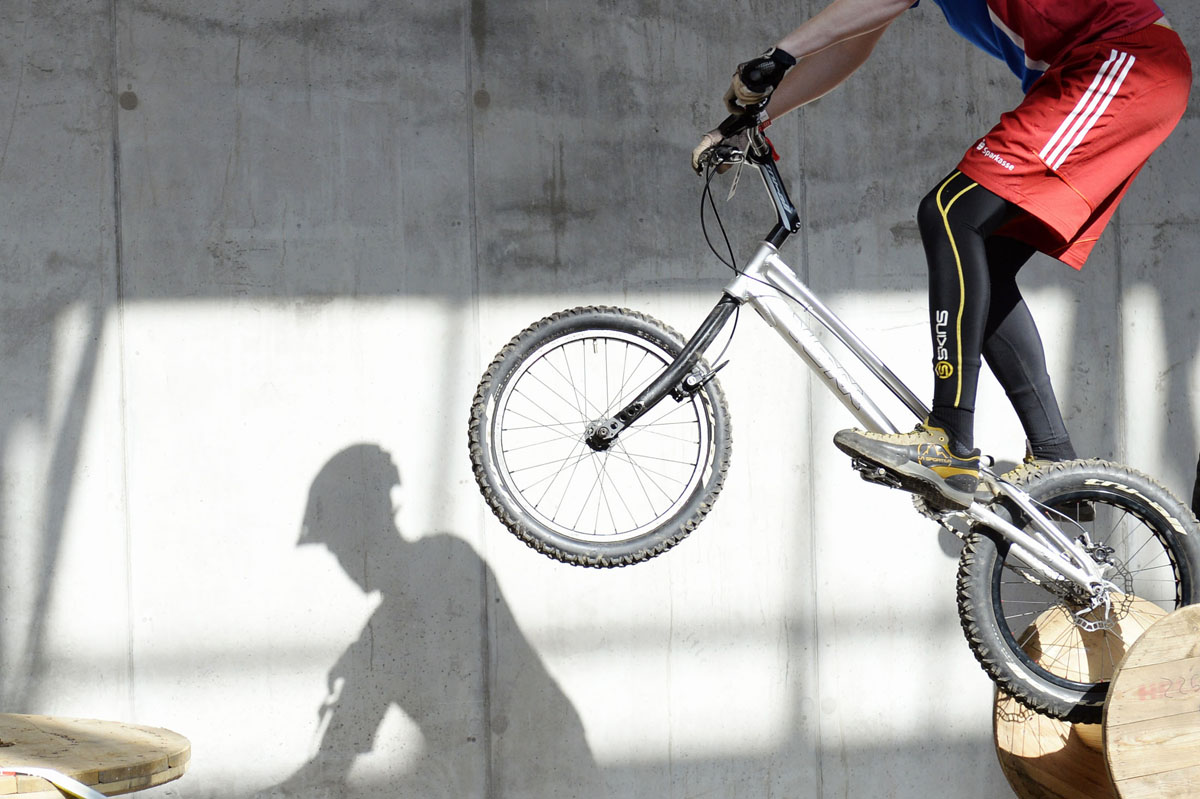World class bike trials in the capital! The Berlin Trials Cup marks the start of competition for the 2017 UCI Trials Calendar. The only UCI Trials Indoor Event in Europe guarantees a fantastic atmosphere. Whether on 20” or 26” size bikes, riders compete in different classes for fame, honor and world ranking points. We spoke with the organizers of the event Frank Drygalla and Ida Steier.
Even for outsiders, it seems as if the Berlin Trials Cup is much more than just another event in the calendar. How did such a contest get started and where does the passion come from?
Frank: I think what’s special is that trials is not yet common in the cycling scene and many people only know the sport from short videos, for example, of Danny MacAskill. But if you then see the top bikers riding over natural obstacles and realize what kind of balance, technique, level, and endurance this sport requires, you just automatically stand still. And wonder at how it is all possible.
Since we, my great team of assistants and I, are all trials riders ourselves, we have all the more incentive to offer something to the athletes. Besides, the trials scene is also one big family, where everyone works together to make the sport more well known. A great competition has grown from a small idea and a bit of naivety.
Trials has a very large and active community, though it’s still a bit overshadowed in the overall picture of the MTB. Many people and even bicycle athletes don’t even know that a sport such as trials even exists. Why is that?
Frank: The main focus of bicycle associations in Germany is on road cycling. Because of this, there is less support and media attention for other “fringe” forms of cycling. In addition, there’s a lot of energy invested in Olympic disciplines, letting other disciplines fall by the wayside – even though Germany is the third strongest trials nation! Slowly, though, a process of rethinking is taking place, and the successes of the German trials athletes are being reported about more often. We are also very happy to be able to bring this sport closer to so many bicycle enthusiasts at the Berliner Fahrradschau.
Ida: Surely it’s also because of the bike culture which is much more active and nurtured in other countries. That’s why, for example, French tourists in the Berlin subway always recognize the bicycle without a seat as “le VTT Trial”.
How exactly can trials actually be defined? How would you explain it to your grandmother? How did the sport come into being?
Ida: “To ride a bicycle over an obstacle course without setting your foot to the ground” – that is certainly the simplest way to explain the basic principle of trials riding. Trials is possible everywhere: whether you want to ride a bike on the small wall in your neighborhood or over a boulder in the park – the aim is to come into contact with an obstacle only with the wheels.
During a trials competition, there’s a penalty point for setting your foot down. Whoever has the fewest penalty points at the end wins. In accordance with your level of proficiency, there are different classes of difficulty and the obstacles become more complex.
Bike trials developed during the 1970s from motorcycle trials where similar rules apply. The children of motorcycle trials riders wanted to imitate their parents and then started riding their bicycles over stones and tree trunks. An autonomous bike sport quickly developed out of this, though you really can’t say where it all really began. It was probably a parallel development in different places.
What do you think of people like Danny MacAskill and Fabio Wibmer? Has the massive media interest in the videos of those guys helped to make the sport more well known or, in your opinion, does it really not have anything to do with trials?
Frank: We are really impressed with what the two of them can do with their more “normal” bikes. And since the word “trials” is always mentioned in connection with this, it can only be advantageous for the sport. Nevertheless, you have to distinguish between street trials and competition trials since each has a different level of proficiency and different priorities. Danny MacAskill once mentioned in an interview that he has the greatest respect for the top competition riders, who really go the extra mile technically in height and range.
Frank, how did you actually come to trials riding?
Frank: Like many others, at the age of around 13, I started trying out tricks with the bicycle in my home town of Eisenhüttenstadt. Backwheel riding, jumping down stairs – the usual things. With time, I found kindred spirits and they introduced me to Hans “No Way” Rey – the trials pioneer himself. We used to meet all the time in a small GT bike shop to watch trials videos of Hans Rey together. And like in the video “Monkey See Monkey Do”, we imitated things and in that way became real trials bikers. When I was 15, I rode my first competition and I’ve been true to the sport ever since. Even then, I thought building obstacles and staking out bike lanes during training was great, and that’s what I can continue to practice now at a very high standard with the Berlin Trials Cup.



